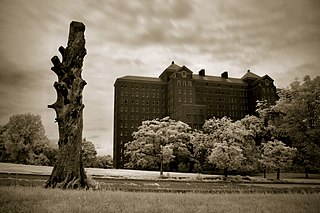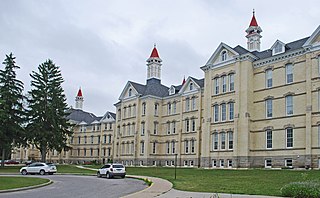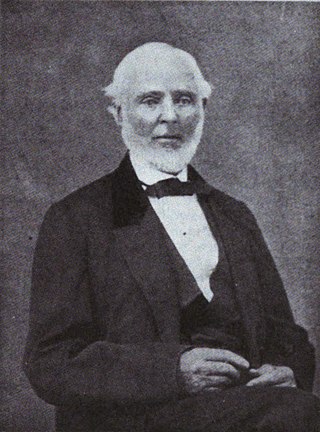
Wayne County is the most populous county in the U.S. state of Michigan. As of 2020, the United States Census placed its population at 1,793,561, making it the 19th-most populous county in the United States. The county seat is Detroit. The county was founded in 1796 and organized in 1815. Wayne County is included in the Detroit-Warren-Dearborn, MI Metropolitan Statistical Area. It is one of several U.S. counties named after Revolutionary War-era general Anthony Wayne.

Hamtramck is a city in Wayne County in the U.S. state of Michigan. An enclave of Detroit, Hamtramck is located roughly 5 miles (8.0 km) north of downtown Detroit, and is surrounded by Detroit on most sides. As of the 2020 census, the city had a population of 28,433, and was by far the most densely populated municipality in Michigan. It is notable as the only Muslim-majority city in the United States.

Northville Township is a charter township in Wayne County in the U.S. state of Michigan. A western suburb of Detroit, Northville Township is located roughly 27 miles (43.5 km) northwest of downtown Detroit, and 20 miles (32.2 km) northeast of Ann Arbor. As of the 2020 census, the township had a population of 31,758. It is independent of the neighboring city of Northville.

Westland is a city in Wayne County in the U.S. state of Michigan. A western suburb of Detroit, Westland is located about 18 miles (29 km) west of downtown Detroit. As of 2022, the city had a population of 84,037.

The Clinton Valley Center (CVC), originally called the Eastern Michigan Asylum for the Insane, was a psychiatric hospital located at 140 Elizabeth Lake Road in Pontiac, Michigan. The facility was designated a Michigan State Historic Site in 1974 and listed on the National Register of Historic Places in 1981, with a decrease in its boundaries in 1986. The facility was closed in 1997 and demolished in 2000.

The Kings Park Psychiatric Center, known by Kings Park locals as "Kings Park Asylum", is a former state-run psychiatric hospital located in Kings Park, New York. It operated from 1885 until 1996, when the State of New York closed the facility, releasing its few remaining patients or transferring them to the still-operational Pilgrim Psychiatric Center.

The Kirkbride Plan was a system of mental asylum design advocated by American psychiatrist Thomas Story Kirkbride (1809–1883) in the mid-19th century. The asylums built in the Kirkbride design, often referred to as Kirkbride Buildings, were constructed during the mid-to-late-19th century in the United States.

The Detroit Medical Center (DMC) is a for-profit alliance of hospitals that encompasses over 2,000 licensed beds, 3,000 affiliated physicians and over 12,000 employees. Located in Midtown Detroit, the DMC is affiliated with medical schools from Wayne State University and Michigan State University. Detroit Medical Center hospitals are staffed by physicians from the Michigan State University College of Osteopathic Medicine and the Wayne State University School of Medicine, the largest single-campus medical school in the United States and the nation's fourth largest medical school overall. The Detroit Medical Center is fully accredited by the Joint Commission on Accreditation of Healthcare Organizations.

St. Florian Church is a Roman Catholic Church at 2626 Poland Street in Hamtramck, Michigan. The church was designed by Ralph Adams Cram of the firm Cram and Ferguson.

The Traverse City State Hospital, also known at various points as the Northern Michigan Asylum and the Traverse City Regional Psychiatric Hospital, is a decommissioned psychiatric hospital in Traverse City, Michigan. Established in 1881 by James Decker Munson and Perry Hannah, the hospital was in operation from 1885 to 1989. The site has since been redeveloped, reopening in 2002 as The Village at Grand Traverse Commons, a social center including shops, restaurants, office space, and residences.
Michigan State Asylum may refer to any number of early mental institutions in the state. Michigan became a state in 1837 and five years later accepted that the principal caring for the mentally afflicted was a state problem. In 1848 a joint resolution required an annual return from the adviser of the number of insane, deaf, dumb, and blind in the state. In that same year the legislature set aside 5,000 acres (2,000 ha) of land for buildings, next year nearly double that amount, and in 1850, 16,000 acres (6,500 ha). Not until 1853 was money, $20,000, appropriated out of the general fund of the state treasury. Many hospitals/prisons have been referred to as "Michigan State Asylum". There were once 16 State-operated psychiatric facilities in Michigan. Between 1987 and 2003 Michigan closed three quarters of its 16 state psychiatric facilities. Here is a partial list.
Joseph Julius Kustus was a professional baseball outfielder for the 1909 Brooklyn Superbas. Tuberculosis forced his early retirement from the game, and contributed to his death at the age of 33.
DMC Sinai-Grace Hospital is one of the eight hospitals that comprise the Detroit Medical Center (DMC). Located in northwest Detroit, Sinai-Grace provides health care services in over forty specialties and has 334 inpatient beds. The hospital has comprehensive cardiovascular, emergency/trauma, cancer, surgical, OBGYN, urological, gastrointestinal, intensive, and geriatrics services.

Springfield University Hospital is a psychiatric hospital in Tooting, South London and also the headquarters of the South West London and St George's Mental Health NHS Trust.
Eloise Cemetery was the name applied to cemeteries used by the Eloise hospital complex located in what was then Nankin Township in western Wayne County, Michigan, and is now Westland, Michigan. The patients buried in the cemetery were from the Infirmary Division, the William P. Seymour General Hospital, the T.B. Sanitarium and the Eloise Hospital. The majority of burials were from the Infirmary Division which was the largest of the three divisions, housing up to 7,000 patients at a time. Most burials were of adult males, but there are women and a few infants and children.

Maryfield Hospital was a hospital in Stobswell, Dundee, Scotland. Originally a poorhouse hospital it became Dundee's second main hospital after Dundee Royal Infirmary. It closed in the 1970s following the opening of Ninewells Hospital.

Eloise is a 2016 American thriller film directed by Robert Legato and written by Christopher Borrelli. The film stars Eliza Dushku, Robert Patrick, Chace Crawford, Brandon T. Jackson, Nicole Forester, and P. J. Byrne. The film was released on February 3, 2017, by Vertical Entertainment.
A Municipal hospital is a hospital under the control of a local government, as opposed to those run commercially, by some sort of charitable organisation, or by national or state governments.

Ammon Brown was an American politician who served two terms in the Michigan House of Representatives. He was also instrumental in forming the Wayne County, Michigan, poorhouse and asylum later known as Eloise, and served as its first keeper.

The Royal Dundee Liff Hospital, previously known as Dundee Lunatic Asylum and Dundee Royal Lunatic Asylum, was a mental health facility originally established in 1812 in Dundee, Scotland. It was originally located in premises in Albert Street Dundee, but later moved out of the town to new buildings in the nearby parish of Liff and Benvie. Buildings at Liff included Greystanes House, which was the main building, and, Gowrie House, which was the private patients' facility. Both Grade B listed buildings.
















